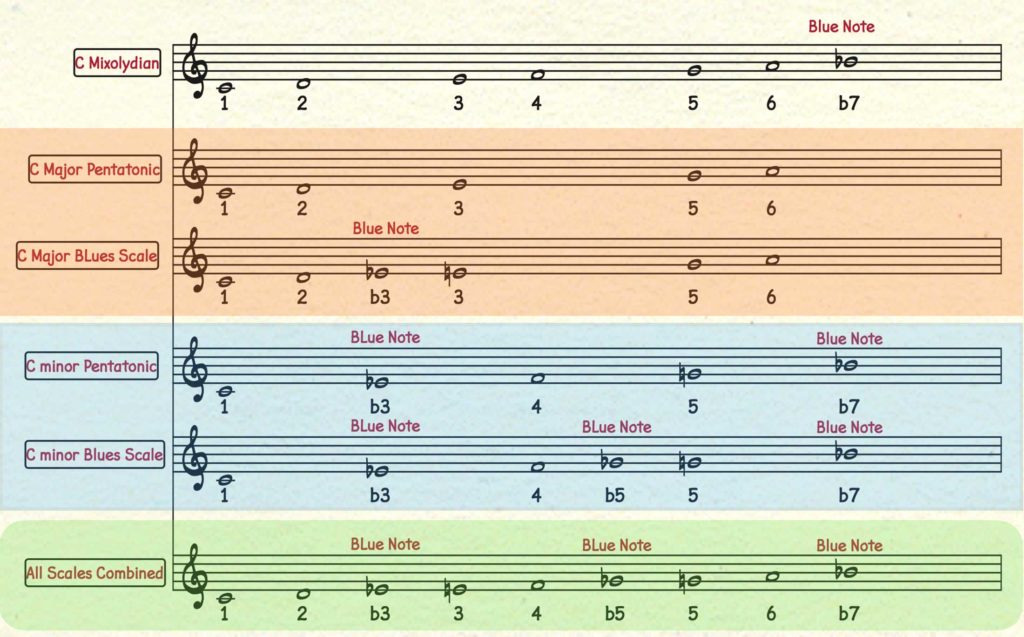What is the Blues Scale?
There are those that argue that there are actually two blues scales:
- The Major Blues Scale (degrees 1, 2, b3(#9), 3, 5, 6), which is based on the major pentatonic scale (1, 2, 3, 5, 6) with an added blue note (b3=#9)
- The Minor Blues Scale ((degrees 1, b3(#9), 3, 4, b5(#11), 5, b7) based on the minor pentatonic scale (1, b3, 4, 5, b7) with added blue note (b5=#11)
The names suggest, that one is used for major keys and the other for minor keys. Well, not so fast. The “minor” blues scale is the most commonly used scale because it works for both tonalities, minor and major. In other words, it sounds great when played over a dominant seventh chord, as well as a minor seventh chord.
The major blues scale is not really so “blue”. To me it’s just the major pentatonic scale with a chromatic passing tone between degree 2 and 3. It can be used for major seventh chords, but major seventh chords by nature don’t sound like blues at all. After all, there is no happier sound than that of a major seventh chord. And HAPPY and BLUES just ain’t go together so well!
The minor blues scale may not sound so great with major seventh chords. But hey, everything goes when you are playing the blues!
Blues Scales Overview
When you hear great jazz players playing blues, they use all kinds of different scales. Below is a table with the most common scales used in jazz and blues music.
Notice that I used different colors to show how the major and minor pentatonic scales relate to the major and minor blues scales.

The last system in the table above shows the notes from all the scales combined. It’s almost the chromatic scale, with the exception of #2, #5, and ∆7. It’s like “everything goes”.
Conclusion
Jazz musicians and contemporary blues musicians do not just stick to one scale. As we have shown above, there are many scales to choose from. What gives music a bluesy feeling and sound has as much to do with how we phrase, the rhythm, dynamics, articulations and embellishments, as it has to do with blue notes.
The pianistic point of view
A guitar or horn player can bend notes like a singer, which is perceived as bluesy, especially when doing it with thirds and fifths. That’s really what the whole idea of playing the blues is focused around. Playing in-between two pitches. Unfortunately, on the piano we have to be magicians to give the illusion of bending notes. We do this by employing grace notes, trills, banging out seconds, and all this other stuff. Thankfully we have electronic keyboards that have a pitch bend and modulation wheel, which is so cool. But ultimately it comes down to Blues Licks for us more than for any other instrumentalist. Albert Amons, Dr. John, Oscar Peterson, and all these other great pianists that played the blues so effectively on the piano, have all been using blues licks to make us all blue. (When I listen to those gentleman, I actually literally get blue, because their playing simply takes my breath away!).
So let’s learn something about blues licks!
